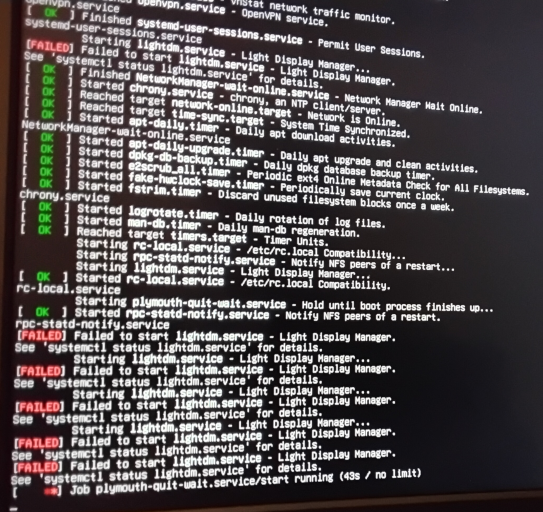Active threads
Showing topics posted in for the last 365 days.
- Past hour
-
I tried the lastest version "Armbian_community_25.11.0-trunk.472_Odroidm2_trixie_edge_6.18.0-rc5_minimal.img". But NPU is not mentioned in dmesg. Also, I have this red line. what could be the effect on the system ?
- Today
-
Hi, just to give a maybe final feedback on this topic: Although it is not a really satisfying solution, I decided to switch off the sysrq functionality by setting kernel.sysrq=0 in /etc/sysctl.conf. This was 1 month ago and there were no sysrq events in my logs since then. So for now this is a "good enough" solution for me. Thank you all for your support, I learned again a lot ...
-
You should check uboot logs if the dtbo is loaded correctly. You can get those using a debug serial console. If you don't know what that is or how to connect: https://debug.armbian.de
-
@blackc Exact the original U-boot DRAM settings from your boot.bin or an update. https://forum.armbian.com/topic/29794-how-to-install-armbian-in-h618/page/23/#findComment-218660 If you are still having issues ask the sunxi guys on IRC. https://oftc.catirclogs.org/linux-sunxi/2025-11-14
-

Efforts to develop firmware for H96 MAX V56 RK3566 8G/64G
王类 replied to Hqnicolas's topic in Rockchip CPU Boxes
Could you please tell me in detail how to use these files? My knowledge of Linux is very limited. Do I need to recompile a custom image suitable for myself, or how should I use these files to carry out specific operations to solve my problem? Thank you. -
I am an Linux Beginner and I only can use Terminal for copy/paste issues. For many months my Raspberry Pi 5 runs perfectly with Armbian. But when I try to update the system in the Discover App, I get the following error message: The following packages have unmet dependencies: kpim6-akonadi: Kollidiert mit: knotes but 4:24.05.2+p24.04+vstable+git20240705.1500-0 is to be installed Kollidiert mit: kpim6-akonadi-notes but 4:24.08.3+p24.04+vstable+git20241129.1417-0 is to be installed Can someone please help me to get my system up-to-date? Thanks in advance!
-
Armbian Bookworm 25.8.1. (minimal) Odroid XU4 with 32GB eMMc After lots of searching and trying 2017 Hardkernel solutions and github etc - And this forum suggestions - I could never get get it to boot. I think this is partly because things have changed since 2016/17. I did not have my eMMc on an usb adapter. Just installed, brand new (untouched from China) eMMc and a imaage install on MicroSD of Armbian. The method I believed should work was "armbian-install". But, it had errors while using mkpartimage. I put debug statements in the script and found the particular instance of invoking mkpartimage. Actually the issue is; 2 files are missing from /boot folder. Current SD installation image of Armbian minimal only creates one fdisk (MBR) partition on which /boot is a folder. I tried for ages to create a separate /boot partition. Maybe, since I have now succeeded with an eMMc install, I might try doing a separate root and boot. The 2 missing files are armbianEnv.txt and boot.cmd If one "touch"es armbianEnv.txt then - if it doesn't exist it will be created - if it does then no harm done. If one copies boot.ini to boot.cmd then these two things will satisfy armbian-install. Amrbian-install correctly changes the R/O of mmcblkXboot1 (where X is emmc device number) write the boot stuff and markit back R/O. It also ensures that armbianEnv.txt has got correct entries in it. In summary Install eMMc and Micro SD in XU4 Ensure SD/eMMc switch set to SD and boot armbian from SD Login as root or use sudo touch /boot/armbianEnv.txt cp /boot/boot.ini /boot/boot.cmd armbian-install choose the install and boot from eMMc option shutdown change switch to boot armbian from eMMc boot
-
Hi @djurny Just to inform you that, after cleaning out some mess I made, your overlay and armbianEnv.txt update to make the external RTC ds3231 to work, did the job. For my SBC's I use the Banana Pi M2 Zero and v25.5 rolling for Banana Pi M2 Zero running Armbian Linux 6.6.75-current-sunxi My application needs to work in the field as an Access Point with an RTC, the right date and time is important info in the diagnostics of my applications. A remark on the mentioned Armbian release: For using the GPIO pins of the SBC, python3-libgpiod works great. I use USB camera's (V4L2 camera). After any update or upgrade, my USB camera's won't work anymore. Not really a problem for me, because I'm happy as it works right now, no updates or upgrades needed. Thanks again for your great help. Met vriendelijke groet, Ed
-
https://github.com/armbian/build/blob/main/config/boards/retroidpocket-rp5.csc https://github.com/armbian/build/blob/main/config/boards/retroidpocket-rpmini.csc You can build images on your own. https://docs.armbian.com/User-Guide_Board-Support-Rules/#community-maintained
-

fail install of xfce desktop on odroidxu4
dev001 posted a topic in Software, Applications, Userspace
Using odroidxu4. flashed Armbian_25.8.1_Odroidxu4_noble_current_6.6.102 to eMMC After odroidxu4 started, followed instruction to create accounts etc. Installed xfce4 package reboot. odroidxu4 booted to console prompt Installed xfce4-goodies package reboot. odroidxu4 booted to console prompt Installed lightdm reboot. The system becomes stuck at plymouth-quit-wait.service/start Not much I could do after this as I could not look at log messages or use $ sudo systemctl status lightdm.service Any insight greatly appreciated Thanks - Yesterday
-

Orange Pi 5 won’t boot from SSD after armbian-install
Efe Çetin replied to Renoria's topic in Orange Pi 5
Choose install/update bootloader on spi flash option on armbian-install. Some uart logs could be useful if you have usb-ttl converter stuff -
Hello all, I have a/m model with 2GiB RAM / 16GiB eMMC- Wifi: XR819 (XRadio XR819). I've download and install a .img file Armbian_community_25.11.0-trunk.437_Tanix-tx6_trixie_current_6.12.47_minimal.img.xz I want to have a server version CLI, but I don't know where to find that. My problem is that the WIFI is not availible after the boot in ARMbian. Is there any solutions for make it availible? Thank you in advance.
-
moved
- 1 reply
-
1
-

mxq pro 4k 5g allwinner h313 can't sd card boot
Ducdanh Nguyen replied to Ducdanh Nguyen's topic in Allwinner CPU Boxes
@Sergey Lepeshkinok -
I did not detect the fancontrol issue sooner as I had not tested the trixie image. Indeed PrivateDevices=no should be set because helios64 and helios4 points fancontrol tu /dev symlinks prepared via udevs rules to sysfs files. I don't know if I can get rid of these udev rules, ie if I have persistend access to the proper sysfs directories for thermal and hwmon required by fancontrol on helios64. I also question why only 3 boards uses fancontrol in armbian. I had a thermal policy patch for the dts, it has the added bonus that it works when the kernel start and until it stops thus no uneeded high fan speed before fancontrol start and after it stops. But I am still wondering why kobol team chossed fancontrol and thus what are the pros and cons of fancontrol vs dts thermal policy. https://github.com/armbian/build/pull/8928 PR to set PrivateDevices=no when one upgrades armbian-bsp-cli-helios64-current or edge is in the pipe.
- Last week
-

No audio output via I²S (PCM5102) on Orange Pi Zero 2W (H618)
Jose Cardoso replied to Jose Cardoso's topic in Off-topic
Hello everyone, As I said, previous post, I’ve been trying to enable I²S audio output on my Orange Pi Zero 2W (Allwinner H618) using an external PCM5102 DAC, but so far the kernel does not recognize any sound device. I read that the driver sound/soc/sunxi/sun4i-i2s.c supports the H6, and “going” (posted March 4) suggested trying: compatible = "allwinner,sun50i-h6-i2s" to trigger that driver, since the H618 I²S block might be similar. Overlay compiles successfully using armbian-add-overlay and loads on boot. However, after reboot: dmesg | grep -i i2s dmesg | grep -i pcm aplay -l → aplay: no soundcards found... Could anyone confirm whether this driver can handle the H618 I²S, or if kernel patching is required to make it work? Any advice or example DTS overlay for H618 + I²S would be very helpful. Thanks in advance for your time and for the excellent work on Armbian Jose Cardoso -
Ah! was that simple huh. Thanks vidplace7! Got it to work once i removed the image on the flash. But I have to put it in maskrom mode if i want to use the SPI in the future which is a pain. Ah well it is fine Also lsusb now works root@luckfox-lyra-zero-w:~# lsusb Bus 001 Device 004: ID 0bda:8152 Realtek Semiconductor Corp. RTL8152 Fast Ethernet Adapter Bus 001 Device 002: ID 1a86:8091 QinHeng Electronics USB HUB Bus 001 Device 001: ID 1d6b:0002 Linux Foundation 2.0 root hub
-
Hello, I have a problem after update on strong leap s1, it is stuck at the android tv loading screen, I found this method (1) Mecool KD3 Stick recovery reset | XDA Forums . Basically because this box doesn't have reset button, this method is can be used to get into recovery mode from where you can factory reset the box. Problem is that it's not working for me, is there anyone with same problem ? How did you solved it, please ? Thanks
-
# TV Box X88PRO13 My TV box is the X88PRO13. It is equipped with the RK3528 chip. I successfully running Armbian on the box. Find How To build and create Image for this BOX on http://github.com/joilg/x88pro A ready to go iso image is on https://github.com/joilg/x88pro/releases/tag/0.3 ------------------------------------------------------------------------------------------------- ## For those who have a different TV Box with RK3528 CPU, try the following procedure: The USB 2.0 and HDMI interfaces are the same for most boxes, so the console output should also be posible over HDMI here. 1. Flash MMC with the x88pro image and insert it into the box's MMC slot. 2. Connect a monitor via the HDMI interface. 3. Connect a USB keyboard to a USB port. 4. Power on the box. 5. In most cases, boot messages appear on the monitor, ending in a login prompt. 6. Follow the instructions on the monitor. ## 7. Extracting the correct DTB file binwalk /dev/mmcblk1 | grep -i "Flattened device tree" This should give output something like this: 67451654 0x4053B06 Flattened device tree, size: 99077 bytes, version: 17 67550731 0x406BE0B Flattened device tree, size: 99112 bytes, version: 17 138280448 0x83DFE00 Flattened device tree, size: 99112 bytes, version: 17 143958080 0x894A040 Flattened device tree, size: 379 bytes, version: 17 143960064 0x894A800 Flattened device tree, size: 99078 bytes, version: 17 Select the row with the largest size value. Replace the placeholders in the following commands: - `<TV_BOX_NAME>` with your box's name - `<START_ADDR>` with the first number from the selected row - `<SIZE>` with the size value from the selected row Extract the DTB file with: dd if=/dev/mmcblk1p2 of=rk3528-<TV_BOX_NAME>.dtb skip=<START_ADDR> count=<SIZE> bs=1 Copy it to boot directory: ```bash cp rk3528-<TV_BOX_NAME>.dtb /boot/dtb-6.1.115-vendor-rk35xx/rockchip/ # or cp rk3528-<TV_BOX_NAME>-android.dtb /boot/dtb-$(uname -r)/rockchip/ ``` Edit the `armbianEnv.txt` file: sed -i '/fdtfile=/c\fdtfile=rockchip/rk3528-<TV_BOX_NAME>.dtb' /boot/armbianEnv.txt sync and reboot your box. Now test if LAN, Audio, IR Remote Control, RTC ... is OK. Wifi is only implemented for the AIC8800 Chip. ### optional convert dtb file to readable DTS source file:: dtc -@ -I dtb -O dts -o rk3528-<TV_BOX_NAME>-android.dts rk3528-<TV_BOX_NAME>-android.dtb ## Additional notes I only have a X88PRO13 box, so I 'm not be able to test whether this works for your device. But it might be worth a try. ### all in one Script #! /bin/sh ## Note:** Replace all placeholders (`<TV_BOX_NAME>`, `<START_ADDR>`, `<SIZE>`) with your actual values. dd if=/dev/mmcblk1 of=rk3528-<TV_BOX_NAME>-android.dtb skip=<START_ADDR> count=<SIZE> bs=1 cp rk3528-<TV_BOX_NAME>-android.dtb /boot/dtb-$(uname -r)/rockchip/ sed -i '/fdtfile=/c\fdtfile=rockchip/rk3528-<TV_BOX_NAME>-android.dtb' /boot/armbianEnv.txt dtc -@ -I dtb -O dts -o rk3528-<TV_BOX_NAME>-android.dts rk3528-<TV_BOX_NAME>-android.dtb ``` ## contribute please report if you have success or anny problens. please contribute also Info to your box, embedded chips (wifi,RTC) and publish your DTB or DTS file.
-

odroid cloudshell2 hktft9340 kernel module missing
ELIAST replied to ELIAST's topic in Advanced users - Development
All. After some more research I could dig further, but still no picture on the tft screen. It seemes, the same probelm already popped up elsewhere: https://github.com/notro/fbtft/issues/577 by using some ideas there, I could achieve the follwoing: [ 11.299717] fbtft: module is from the staging directory, the quality is unknown, you have been warned. [ 11.305551] fb_hktft32 spi1.0: fbtft_property_value: bpp = 16 [ 11.305563] fb_hktft32 spi1.0: fbtft_property_value: debug = 0 [ 11.305574] fb_hktft32 spi1.0: fbtft_property_value: rotate = 270 [ 11.305584] fb_hktft32 spi1.0: fbtft_property_value: fps = 20 [ 4.988032] /soc/spi@12d30000/hktft_cs_ogst@0: Fixed dependency cycle(s) with /soc/spi@12d30000/hktft_cs_ogst@0/hktft_cs_ogst_pins [ 11.305404] SPI driver fb_hktft32 has no spi_device_id for odroid,hktft32 [ 11.855462] graphics fb0: fb_hktft32 frame buffer, 320x240, 150 KiB video memory, 4 KiB buffer memory, fps=20, spi1.0 at 40 MHz Which seemes the display is visible by the system now. fbset mode "320x240" geometry 320 240 320 240 16 timings 0 0 0 0 0 0 0 nonstd 1 rgba 5/11,6/5,5/0,0/0 endmode following this route: https://unix.stackexchange.com/questions/20458/how-to-use-dev-fb0-as-a-console-from-userspace-or-output-text-to-it To use the framebuffer as console you need the fbdev module. Ok, let's see this. config-6.6.113-current-odroidxu4 has reference saying ONFIG_FRAMEBUFFER_CONSOLE=y so the above referenced fbdev should already be here. The lcd scripts coming with cloudhell al trying to send text to /dev/tty1 as the output console. So I assume, I should have something similar: dmesg|grep tty [ 0.000000] Kernel command line: splash=verbose console=ttySAC2,115200n8 console=tty1 consoleblank=0 loglevel=1 root=UUID=4cac61c9-e109-4524-9fd2-c9859f87842c rootfstype=ext4 rootwait rw drm_kms_helper.edid_firmware=edid/1024x768.bin smsc95xx.macaddr=00:1e:06:61:7a:55 governor=ondemand hdmi_tx_amp_lvl=31 hdmi_tx_lvl_ch0=3 hdmi_tx_lvl_ch1=3 hdmi_tx_lvl_ch2=3 hdmi_tx_emp_lvl=6 hdmi_clk_amp_lvl=31 hdmi_tx_res=0 HPD=false vout=dvi usb-storage.quirks=0x2537:0x1066:u,0x2537:0x1068:u [ 0.002547] printk: console [tty1] enabled [ 2.122547] 12c00000.serial: ttySAC0 at MMIO 0x12c00000 (irq = 124, base_baud = 0) is a S3C6400/10 [ 2.123447] 12c20000.serial: ttySAC2 at MMIO 0x12c20000 (irq = 125, base_baud = 0) is a S3C6400/10 [ 2.123502] printk: console [ttySAC2] enabled [ 9.707531] systemd[1]: Created slice system-serial\x2dgetty.slice - Slice /system/serial-getty. [ 9.716917] systemd[1]: Expecting device dev-ttySAC2.device - /dev/ttySAC2... ttySAC is the UART what I'm using at the moment. tty1 however is my main "screen", on the HDMI. So the question is, how should I able to tell the system to open an other tty console with fbdev for the LCD screen? -
Good that it can be updated quite easily, although I am not sure about longer-term. In order to see what it is, I took a quick-and-dirty approach, so not running an install script but taking NextcloudPi_RaspberryPi4_v1.55.3.zip and make that run as/via UEFI. Reason is that Raspberry's must have 2 partitions, 1st must be FAT, so this I know can co-exist with EFI booting. Most other SBC images use 1 ext4 partition, so there is no FAT boot partition where EFI/boot/bootaa64.efi can be placed. I symlink between folders 'firmware' and 'efi' in /boot/, so no change in fstab needed to get it running. It turns out the image is a bit older Armbian Bookworm, not Raspberry Pi OS, so I had to delete some script in /etc/kernel/postinst.d/ and /etc/kernel/postrm.d/ Current Armbian RPI images use a script from RPL (Raspberry Pi OS). For this case I did just direct-boot a Debian13 kernel, copied from other Debian13 Arm64 VM. Once booted, I had to do some DNS fixes (standard fixed 1.0.0.1) and install grub-efi and install it and set boot partition to type 0xEF. As indicated, this also works on a real SD-card taken from an RPI (at least the 4 and 5). The 3 needs a hybrid partition table as the bootROM does not boot from MBR type 0xEF and TianoCore UEFI won't boot from a type 0x0C or other FAT type tag. I see https://www.armbian.com/qemu-uboot-arm64/ list 2 variants, I guess first is UEFI, but have not downloaded it. I use flat/raw images, not QCOW2, so same as SD-card, USB-sticks etc. The second states U-Boot, so I think this needs direct QEMU with -bios option and rather extensive set of options. It is fine for CLI only and fast way to get a single partition image running. Both are Ubuntu and looking at x86-VMs from Nextcloud, I see Ubuntu is needed, so maybe a good starting point. Else use Armbian build.
-

warm reboot fails to boot (boot device not found)
eselarm replied to Peter Quiring's topic in Libre Sweet Potato
Make sure you can see and follow kernel messaging when initiating reboot. So another computer that taps serial serial console while you have loglevel=7 for the Potato. -
Fixed the automatic first boot configuration on Bookwarm. Now you can boot the desktop image without a usb serial device.
-

Gaming experience with Orange Pi 5 (RK3588) on Armbian
Alex Ling replied to KhanhDTP's topic in Orange Pi 5
Thank you very much! Very useful information.





